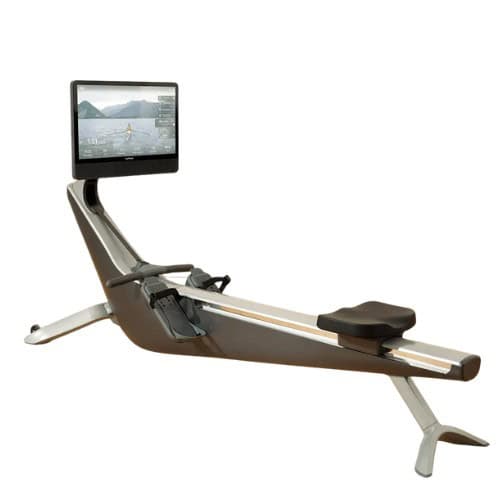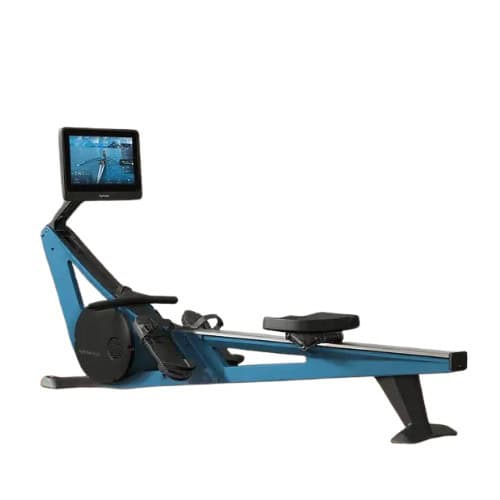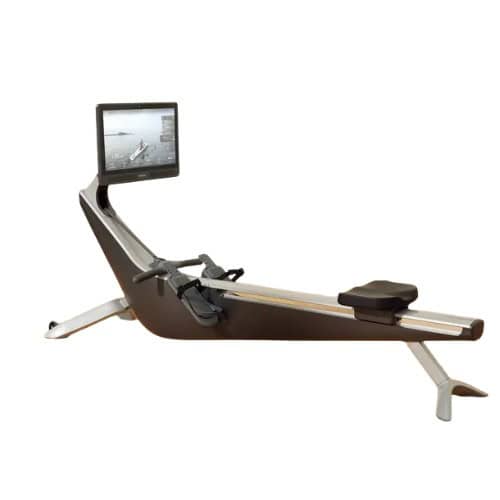Arc vs Origin vs Wave – Which Model Is Right for You? Three models, one goal: bringing the experience of rowing on water into your home. After months of testing all three Hydrow rowers, here’s everything you need to know.
What We Liked
- ✓ Outdoor rowing content is genuinely immersive – Real locations worldwide, not green screen studios
- ✓ Electromagnetic resistance is incredibly smooth – Quieter and smoother than air rowers
- ✓ Massive workout library – Over 5,000 classes beyond just rowing
- ✓ Real-time leaderboards – Surprisingly motivating to watch your rank climb
- ✓ Excellent hardware quality – Solid frames, comfortable seats, thoughtful design
- ✓ Wave offers outstanding value – 90% of the experience for much less money
- ✓ Beginner-friendly content – “Learn to Row” programs make it accessible
- ✓ Family-friendly membership – Unlimited user profiles included
What Could Be Better
- ⊘ Origin’s pricing doesn’t make sense – Hard to justify vs the Wave
- ⊘ Arc is louder than expected – Not whisper-quiet like most magnetic rowers
- ⊘ Wave’s screen doesn’t rotate – Limits off-rower workout visibility
- ⊘ Vertical storage kit costs extra – $80 for Arc and Origin (Wave includes it)
- ⊘ Warranty is shorter than competitors – 12 months vs Concept2’s 24 months
- ⊘ No Netflix or third-party apps – Locked into Hydrow’s ecosystem only
If you’ve been researching rowing machines, you’ve probably noticed that Hydrow keeps popping up. And for good reason.
This isn’t your typical rowing machine that sits in the corner collecting dust. Hydrow has managed to do something most fitness equipment companies struggle with: they’ve made indoor rowing actually enjoyable.
I’ve spent considerable time testing all three Hydrow models (the Arc, the Origin, and the Wave), and what sets these machines apart isn’t just the hardware. It’s the entire experience. Founded by Bruce Smith, a former coach of the US national rowing team with a lifetime of championship rowing experience, Hydrow was built by someone who genuinely understands the sport. That passion shows in every detail.
These rowers aren’t cheap, and they require a monthly membership to unlock their full potential.
So the question isn’t just “should I buy a Hydrow?” It’s “which Hydrow should I buy, and is it worth it for my specific situation?”
So what makes Hydrow different, how do the three models compare, and which one (if any) makes sense for your home gym?
Table of Contents
▼What Makes Hydrow Different?
3 machine options
Hydrow Wave: The most compact and budget-friendly model with a 16-inch fixed screen, polymer frame, and built-in vertical storage. Same electromagnetic resistance and content library as pricier models at a significantly lower price point.
Hydrow Origin: The classic model featuring a 22-inch rotating touchscreen, aluminum/steel frame, and the full Hydrow rowing experience. Lacks the advanced HydroMetrics tracking found on the Arc but delivers smooth, quiet performance.
Hydrow Arc: The premium option with a 24-inch rotating touchscreen and AI-powered HydroMetrics technology that analyzes your rowing form. Features precision, power, and endurance tracking with personalized feedback after every session.
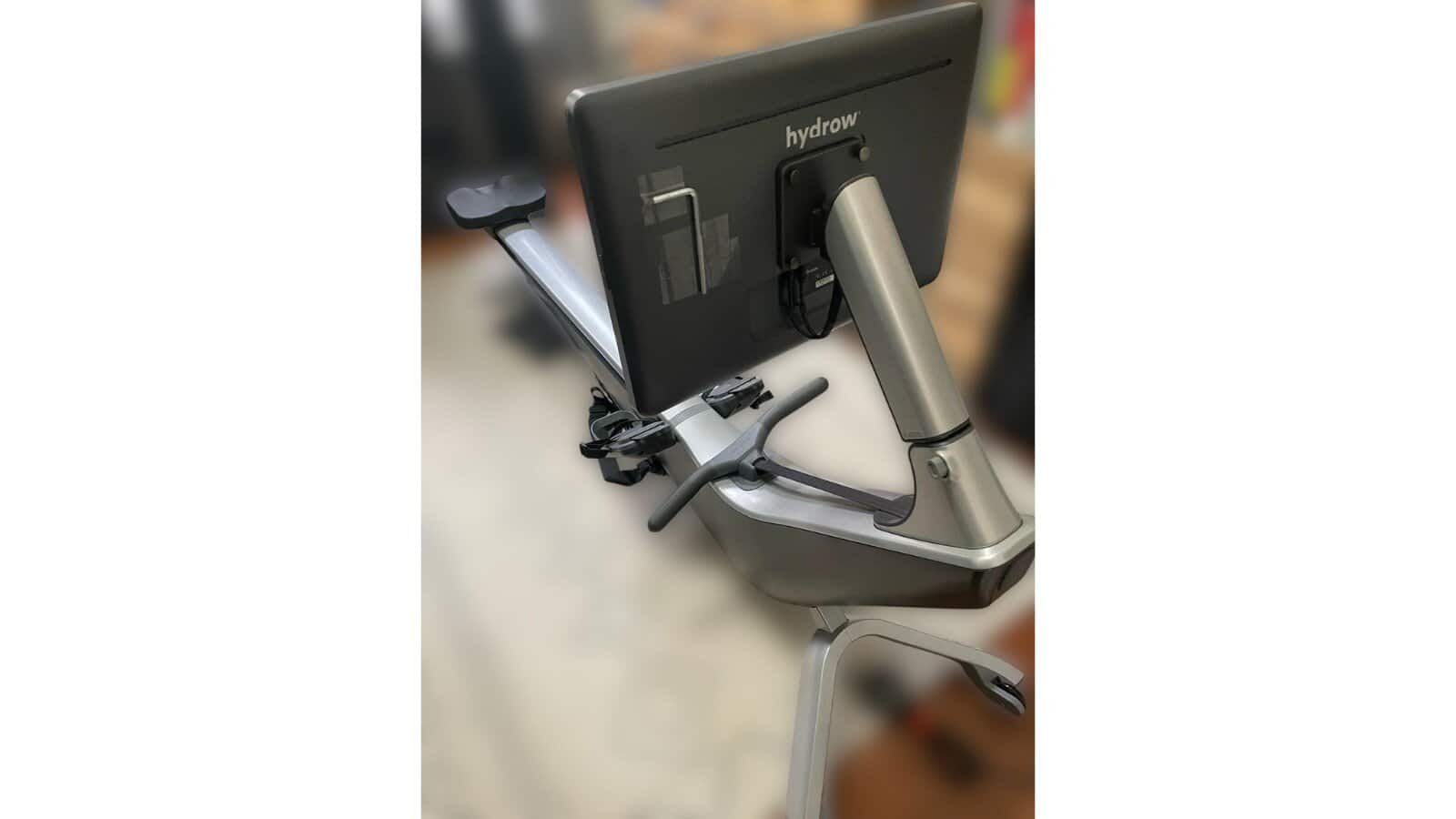
Before we get into the individual models, understand what you’re actually buying when you invest in a Hydrow. This isn’t just a piece of exercise equipment. It’s a complete training platform.
The On-Water Rowing Experience
The biggest differentiator with Hydrow is the content. While other smart rowers have dabbled in various approaches (gaming elements, competitive racing, scenic videos), Hydrow focuses on recreating the experience of actually rowing on water.
The instructors film workouts in real locations around the world. Rivers in Prague, waterways in Sweden, coastal routes in Chile. The camera work is immersive, the locations are genuinely beautiful, and the instructors guide you through each workout while you follow along on their actual outdoor rows.
I’ve tested virtually every smart rower on the market, and nothing else comes close to capturing this experience. It’s calming, motivating, and genuinely makes you forget you’re exercising in your garage or spare bedroom.
The Electromagnetic Resistance System
All three Hydrow models use the same patented electromagnetic drag mechanism. This is crucial to understand because it’s what makes the rowing feel smooth and realistic.
Unlike air rowers (which can be loud and feel jarring) or water rowers (which require maintenance and can be inconsistent), electromagnetic resistance is nearly silent and infinitely adjustable. Hydrow offers 300 levels of resistance, ranging from 50 all the way up to 300. The preset is 104, which Hydrow claims feels most similar to rowing on actual water.
After rowing on all three models, I can confirm the resistance is smooth. Really smooth. Actually smoother than the Concept2 RowErg, which is considered the gold standard for air rowers. There’s no lag, no inconsistency, just a fluid pull that mimics the catch and drive of real rowing.
The Membership Requirement
To be honest, you basically need the Hydrow membership to make these rowers worthwhile. It costs $44 per month, and while you can technically use the rower without it in “Just Row” mode, you lose almost everything that makes Hydrow special.
Without the membership, you can’t save your metrics, you can’t join challenges or leaderboards, you can’t connect to external services like Strava, and obviously you can’t access any of the content. The only thing you can do is connect a Bluetooth heart rate monitor and row while watching basic stats.
Hydrow’s position is clear: if you don’t want to pay for the membership, buy a different rower.
And honestly, I agree with them. Without the membership, you’re paying premium prices for what amounts to a very nice but very basic rowing machine.
The good news? The membership covers unlimited user profiles for your entire household. My spouse and I both have our own accounts, tracking our individual metrics and progress. If you have multiple people using the rower, that $44 per month becomes more reasonable.
The Content Library and Features
With the membership, you get access to over 5,000 workouts. That’s not an exaggeration. The library is massive, and it’s not just rowing.
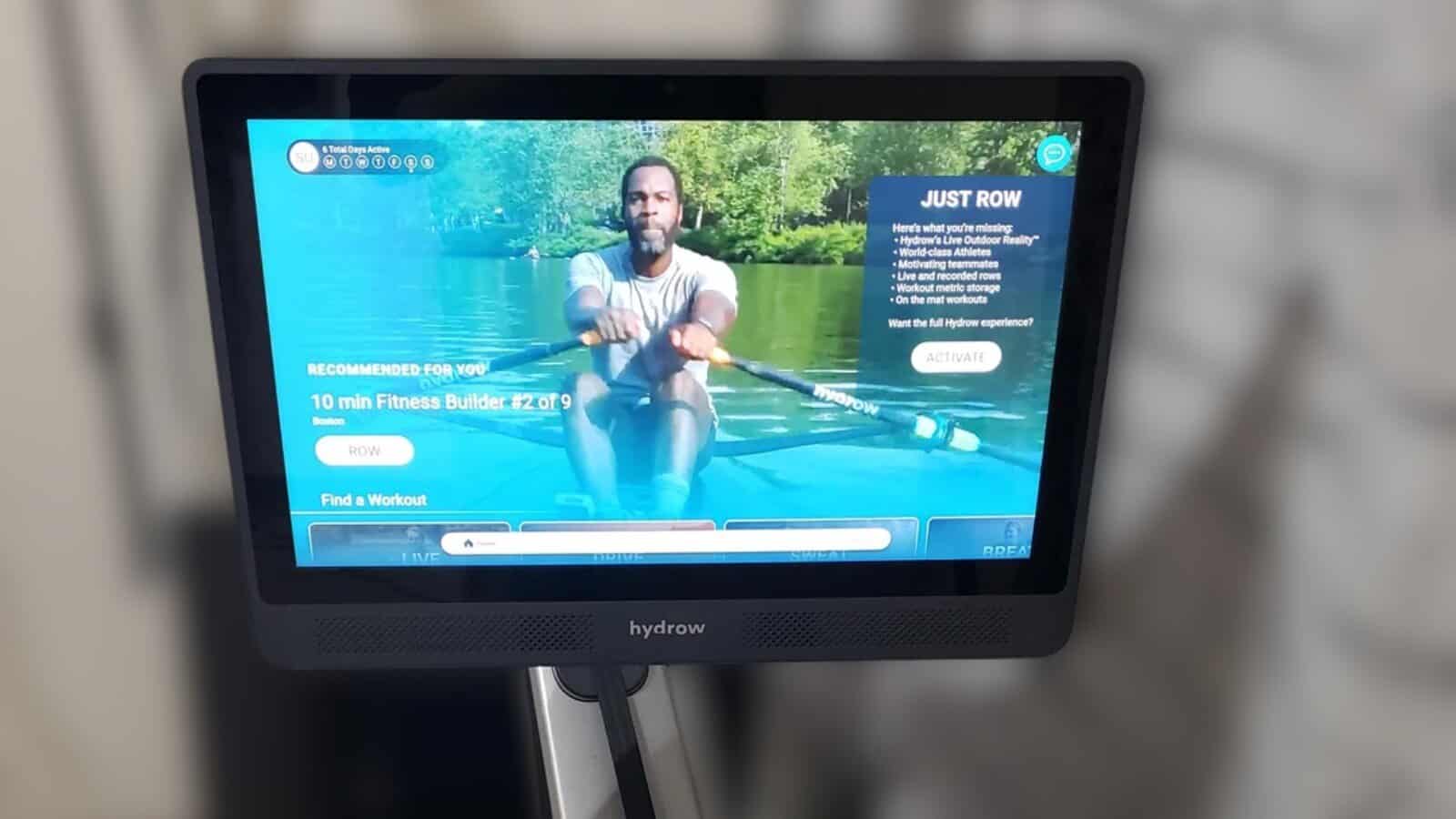
Workout Variety
The rowing workouts are divided into several categories:
- Live Classes: Scheduled sessions where you row alongside other members in real-time
- On-Demand Rows: The outdoor, on-water filmed sessions that Hydrow is known for
- Indoor Studio Rows: Traditional instructor-led classes filmed in a studio setting
- Breathwork and Recovery: Lower-intensity sessions focused on technique and mindfulness
You can filter by instructor, duration (anywhere from 10 minutes to 60+ minutes), workout type, skill level, and even specific locations or music genres. One day I was in the mood for a 20-minute moderate-intensity row with ’90s hip-hop playing. Found it in about 30 seconds.
Off-Rower Workouts
The membership also includes strength training, yoga, Pilates, circuit training, mobility work, and stretching routines. The team was skeptical about these at first (we bought a rower to row, after all), but they’ve actually become valuable additions to our training.
The screen on the Arc and Origin models can rotate and tilt, making it easier to follow along with floor workouts positioned beside the rower. The Wave’s screen doesn’t swivel, which limits visibility for these off-rower sessions, but you can still do them.
Competitive Features and Tracking
If you’re motivated by competition (and I am), the worldwide leaderboard is fantastic. During every workout, you can see how you stack up against other members taking the same class. Your rank updates in real-time based on your output, and it’s surprisingly motivating to see yourself climbing from 247th to 183rd place mid-row.
The platform tracks everything: total meters rowed, active days, personal records, split times, stroke rate, calories burned. You earn badges for milestones and achievements. It’s gamified without feeling gimmicky.
You can also connect external heart rate monitors via Bluetooth. I use mine during every session, and the integration is seamless. The platform even supports Strava integration, automatically posting your workout summaries and stats if you want to share your training with a broader community.
Hydrow Arc: The Premium Option
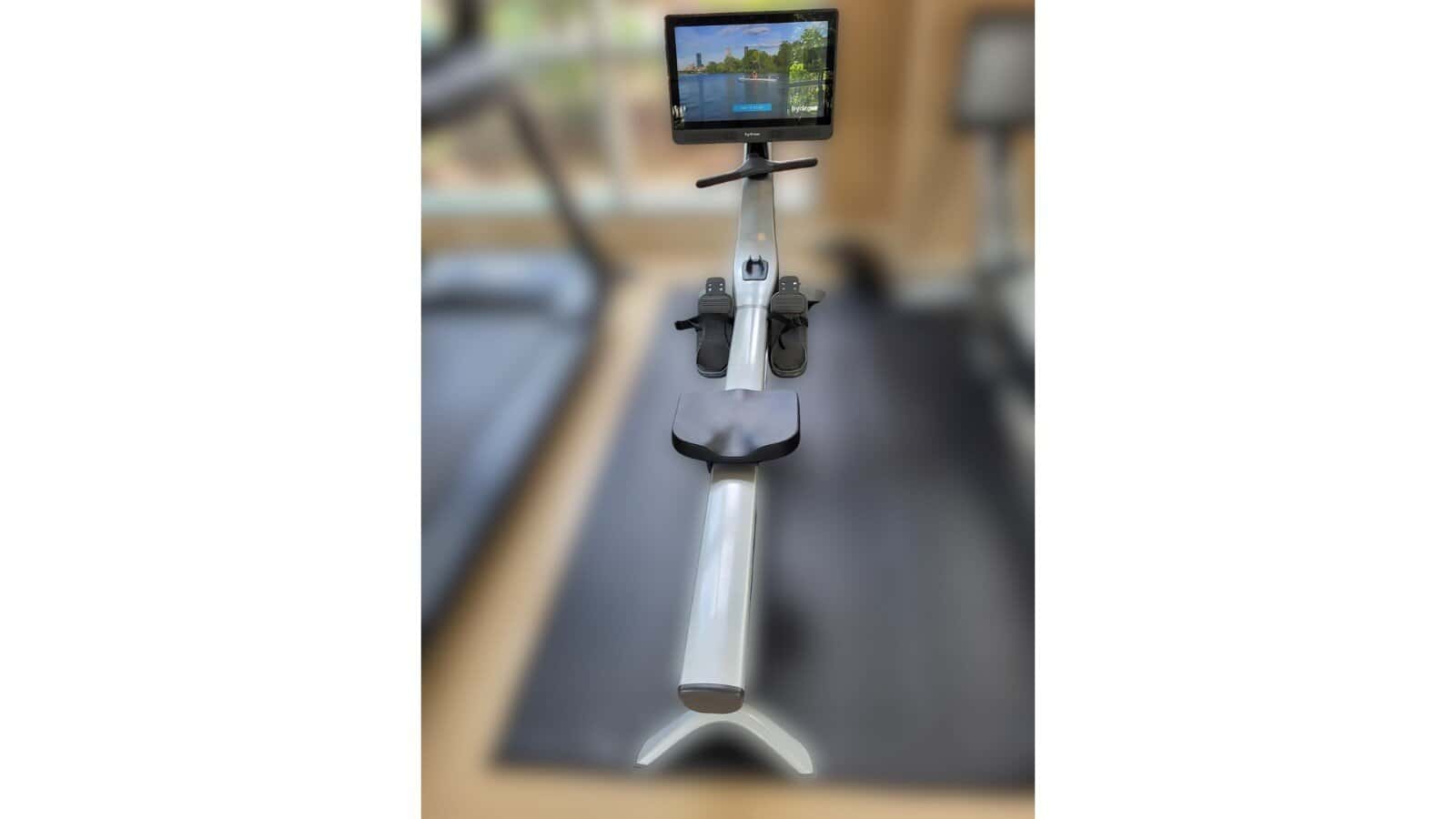
Price: $2,295
The Arc is Hydrow’s newest and most expensive model. It’s also the most technologically advanced, featuring innovations not found on the other two models.
The Arc has the largest display of the three models: a 24-inch HD touchscreen that’s bright, responsive, and easy to navigate. The screen rotates left and right and tilts up and down, giving you maximum flexibility for both on-rower and off-rower workouts.
The frame is constructed from aluminum and steel, and it feels solid. Absolutely solid. At 147 pounds, it’s the heaviest of the three (200 pounds in the shipping box), but that weight contributes to its stability. Even during high-intensity intervals, there’s zero wobble or flex.
The seat is ergonomically padded and extremely comfortable. Probably the most comfortable rowing seat I’ve used. It runs on 10 rollers, creating a smooth, nearly silent glide along the rail. The handle is cushioned with finger grooves, and the foot cradles are fully adjustable with secure straps.
This is what separates the Arc from the Origin. HydroMetrics is Hydrow’s AI-powered performance tracking system, and it’s legitimately useful.
After every rowing session, the Hydro Index breaks down your performance across three key metrics: precision, power, and endurance. The system learns how you move and provides specific feedback on what you’re doing well and where you can improve.
For example, after one session, HydroMetrics told me my power output was strong but my precision was inconsistent (meaning my stroke rate was fluctuating more than it should). It recommended specific drills to work on maintaining a steady rhythm. This kind of detailed feedback is invaluable if you’re serious about improving your rowing technique.
The Arc measures 86 inches long, 25 inches wide, and 48 inches high when in use. That’s a substantial footprint, and you need to account for a bit of extra space around it for comfortable rowing.
The rower can’t be stored upright unless you purchase the upright storage kit, which costs an additional $80. With the kit installed, the vertical storage dimensions are 25 inches wide, 33 inches deep, and 86 inches high. Still a decent amount of space, but significantly less than when the rower is lying flat.
Moving the Arc isn’t difficult thanks to the wheels on the front, but at 147 pounds, it’s not something you’ll want to shift around frequently.
The Arc is built for serious rowers and fitness enthusiasts who want the most advanced training experience Hydrow offers. If you care about detailed performance metrics, form analysis, and marginal improvements in your technique, the HydroMetrics system justifies the premium price.
It’s also the best choice if you plan to use a lot of the off-rower content. The large, rotating screen makes floor workouts much easier to follow compared to the other models.
I need to mention something that surprised me: the Arc is not as silent as I expected.
Magnetic rowers are typically whisper-quiet, but I definitely heard noise with every pull on the Arc. It’s not as loud as an air rower, and it’s comparable to a water rower, but it’s noticeably louder than I anticipated.
This doesn’t bother me, but if you live in an apartment with thin walls or you’re planning to row early in the morning while others are sleeping, it’s something to consider.
Hydrow Origin: The Classic Choice
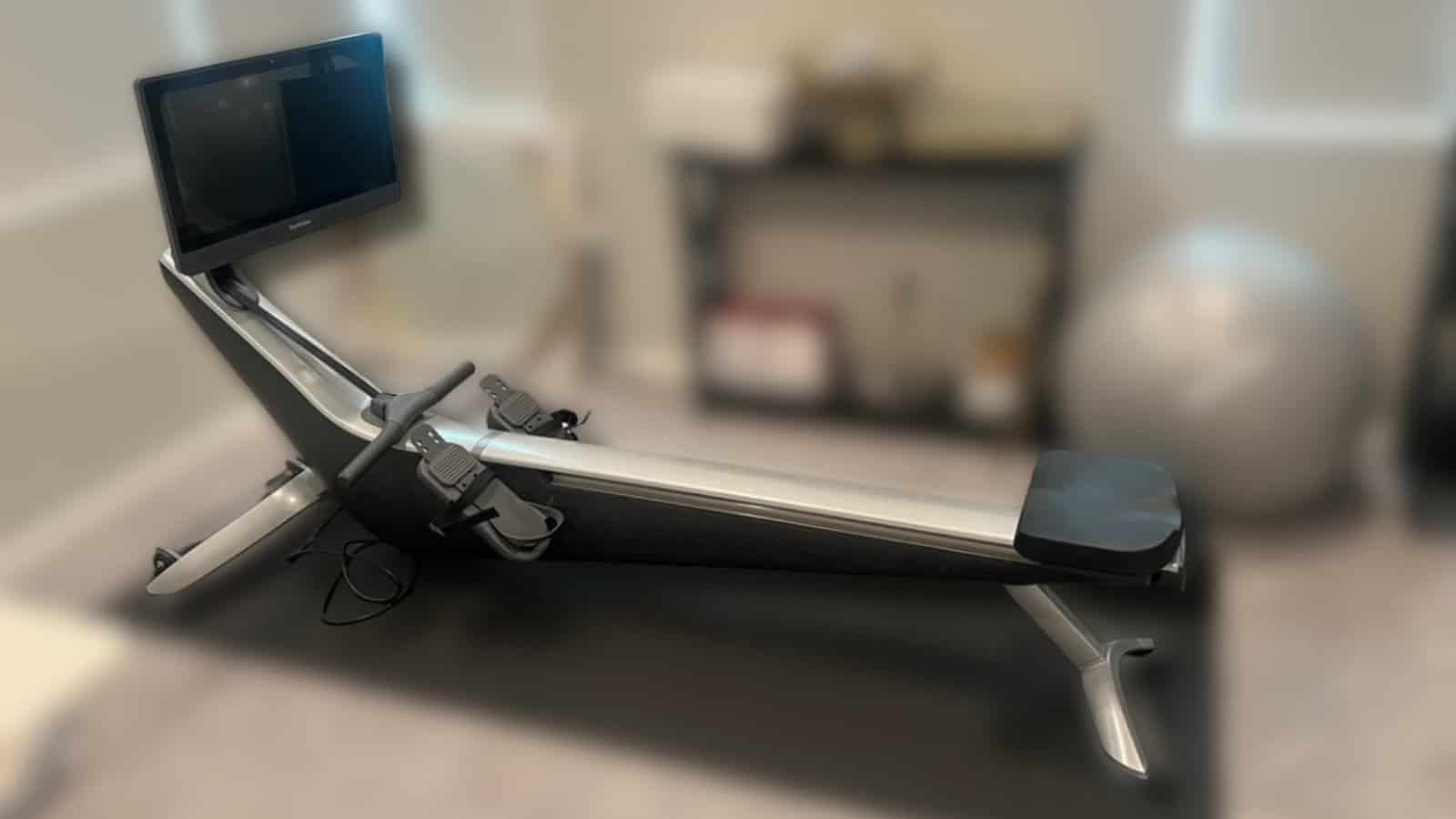
Price: ~$2,200 (often on sale)
The Origin is what most people think of when they hear “Hydrow.” It was the original model that put the company on the map, and it remains an excellent option.
The Origin shares many characteristics with the Arc. It has a steel and aluminum frame, the same comfortable 10-roller seat, the same ergonomic handle, and the same electromagnetic resistance system with 300 levels of drag.
The screen is slightly smaller at 22 inches, but it’s still plenty large for the viewing distance. Like the Arc, it can rotate and tilt for off-rower workouts. The display is bright and crisp, though you can see individual pixels if you look closely (it’s not the highest resolution panel I’ve tested).
The dimensions are nearly identical to the Arc: 86 inches long, 25 inches wide, and 47 inches high. Weight capacity is 350 pounds, which is on the higher end for magnetic rowers (though still less than competitors like the Concept2 at 500 pounds or WaterRower at 700 pounds).
The Origin doesn’t have HydroMetrics. You’ll still get all the standard workout metrics (split time, stroke rate, distance, calories, heart rate), but you won’t get the AI-powered form analysis and detailed performance breakdowns that come with the Arc.
For most people, this isn’t a dealbreaker. The standard metrics are more than enough to track progress and stay motivated. But if you’re a data nerd or serious about optimizing your technique, you’ll feel the absence.
Like the Arc, the Origin can be stored vertically with an additional storage kit. The wheels on the front make it relatively easy to move, though at 145 pounds, it’s still a commitment.
The Origin is the best choice for most people. You get the full Hydrow experience (the same content library, the same smooth resistance, the same high-quality hardware) without paying the premium for HydroMetrics.
If you’re new to rowing or you’re primarily interested in the immersive outdoor workouts and not deeply concerned with performance analytics, save the money and go with the Origin.
Hydrow Wave: The Compact Contender
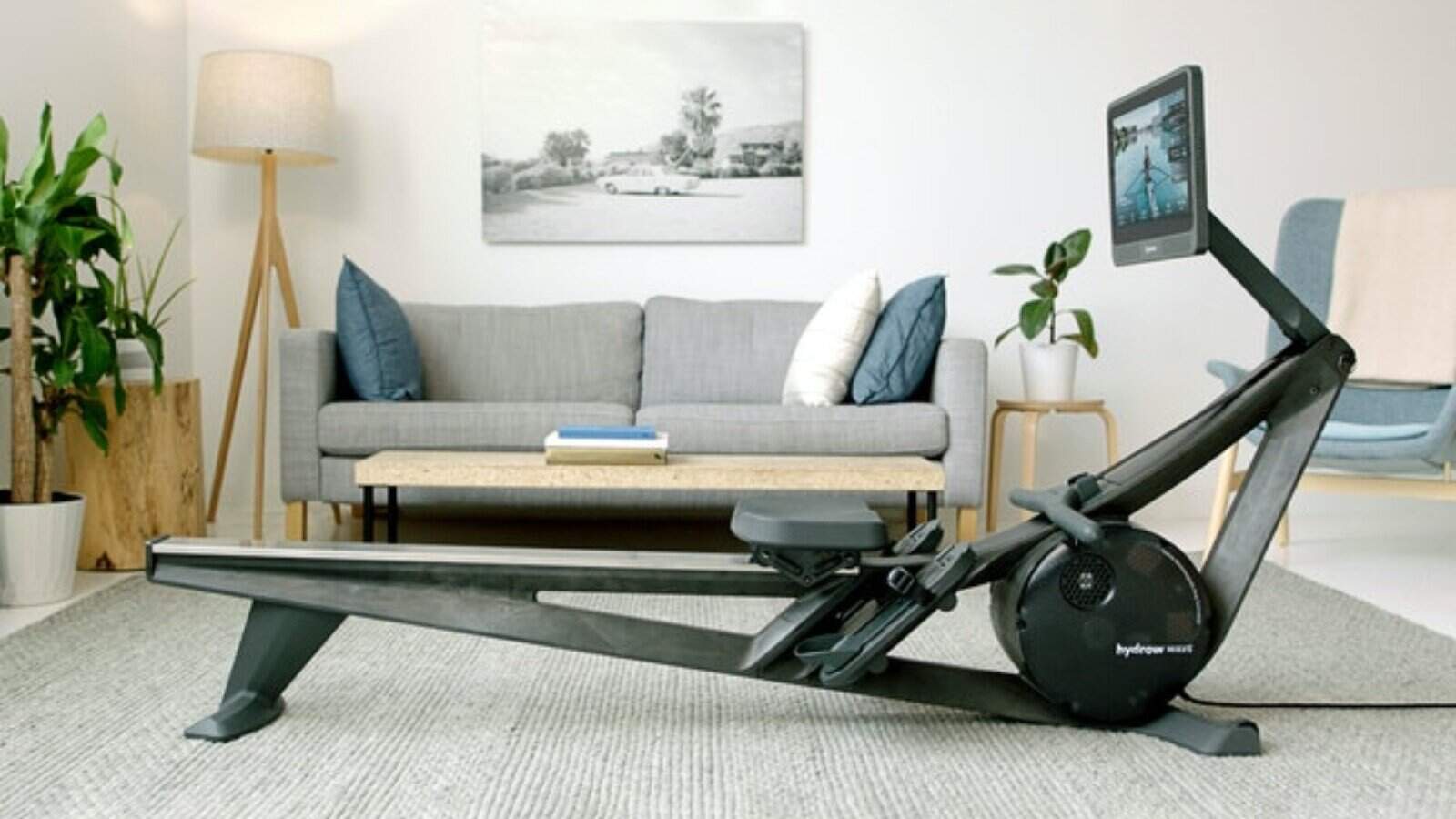
Price: Under $1,500
The Wave is Hydrow’s answer to the Concept2 RowErg. It’s smaller, lighter, significantly cheaper, and in my opinion, the best value in the lineup.
While the Arc and Origin use metal frames, the Wave is constructed from a polymer (high-grade plastic) mold. Before you dismiss it, understand that this isn’t cheap, flimsy plastic. The material provides more than enough rigidity for intense workouts, and it allows Hydrow to dramatically reduce the weight and price.
The Wave weighs just 102 pounds compared to the 145-147 pounds of its siblings. That might not sound like a huge difference, but in practice, it makes the Wave much easier to move around and store.
Despite being more compact overall (80 inches long, 19 inches wide, and 43 inches high), the rail length is the same as the other models at 47 inches. Taller users get the same amount of travel and won’t feel cramped.
What matters most: the Wave uses the exact same electromagnetic resistance mechanism as the Arc and Origin. Same 300 levels of resistance, same smooth feel, same realistic rowing experience. I’d actually argue the Wave’s rail might be even smoother than the metal rail on the Origin, though that could be subjective.
The seat is just as comfortable, the handle is identical, and the foot cradles are the same. You’re not sacrificing anything in terms of the actual rowing experience.
The Wave has a 16-inch fixed HD touchscreen. It doesn’t rotate or swivel like the screens on the Arc and Origin. For rowing workouts, the screen size is perfectly adequate. You’re sitting close enough that 16 inches provides plenty of visibility.
Where it becomes limiting is with off-rower workouts. If you’re doing yoga or strength training beside the rower, you can’t angle the screen toward you. You’ll have to position yourself awkwardly or accept a less-than-ideal viewing angle.
I suspect Hydrow intentionally limited this feature to create differentiation and encourage upgrades to the pricier models. It’s the right business decision, but it’s still a bit annoying.
This is where the Wave really shines. At 102 pounds, it’s light enough that I can move it around solo without much effort. It stores vertically by simply removing a pin, and because of the reduced weight, I’m far more likely to actually fold it up and get it out of the way when not in use.
The Wave ships in a box via UPS instead of on a freight pallet like the other models. If you live in an apartment or don’t have a large driveway for freight delivery, this is a significant practical advantage.
Assembly is minimal. The rower arrives mostly put together, and finishing the setup takes less than 15 minutes.
The Wave is the best choice for anyone with space constraints, anyone on a tighter budget, or anyone who primarily cares about rowing and isn’t as interested in the off-rower content.
It’s also an excellent option if you’re new to rowing and aren’t sure how much you’ll use the machine. The lower price point makes it less risky, and if you fall in love with rowing, you can always upgrade later.
I’d choose the Wave over the Origin for most people. The only reason to spend the extra money on the Origin is if you really want the larger, rotating screen for off-rower workouts.
Head-to-Head Comparison
How do these three models stack up across the factors that matter most?
Comparison Table
| Feature | Hydrow Arc | Hydrow Origin | Hydrow Wave |
|---|---|---|---|
| Price | $2,295 | ~$2,200 | Under $1,500 |
| Screen Size | 24″ HD touchscreen | 22″ HD touchscreen | 16″ HD touchscreen |
| Screen Movement | Rotates and tilts | Rotates and tilts | Fixed (no rotation) |
| Dimensions (L×W×H) | 86″ × 25″ × 48″ | 86″ × 25″ × 47″ | 80″ × 19″ × 43″ |
| Weight | 147 lbs | 145 lbs | 102 lbs |
| Weight Capacity | 375 lbs | 350 lbs | 350 lbs |
| Frame Material | Aluminum/steel | Aluminum/steel | Polymer |
| Resistance Levels | 300 (electromagnetic) | 300 (electromagnetic) | 300 (electromagnetic) |
| HydroMetrics | Yes | No | No |
| Vertical Storage | Yes (kit required, $80) | Yes (kit required, $80) | Yes (built-in) |
| Shipping | Freight pallet | Freight pallet | UPS box |
| Max Height | 6’4″-6’8″ (36″ inseam) | 6’4″-6’8″ (36″ inseam) | 6’4″-6’8″ (36″ inseam) |
Performance and Feel
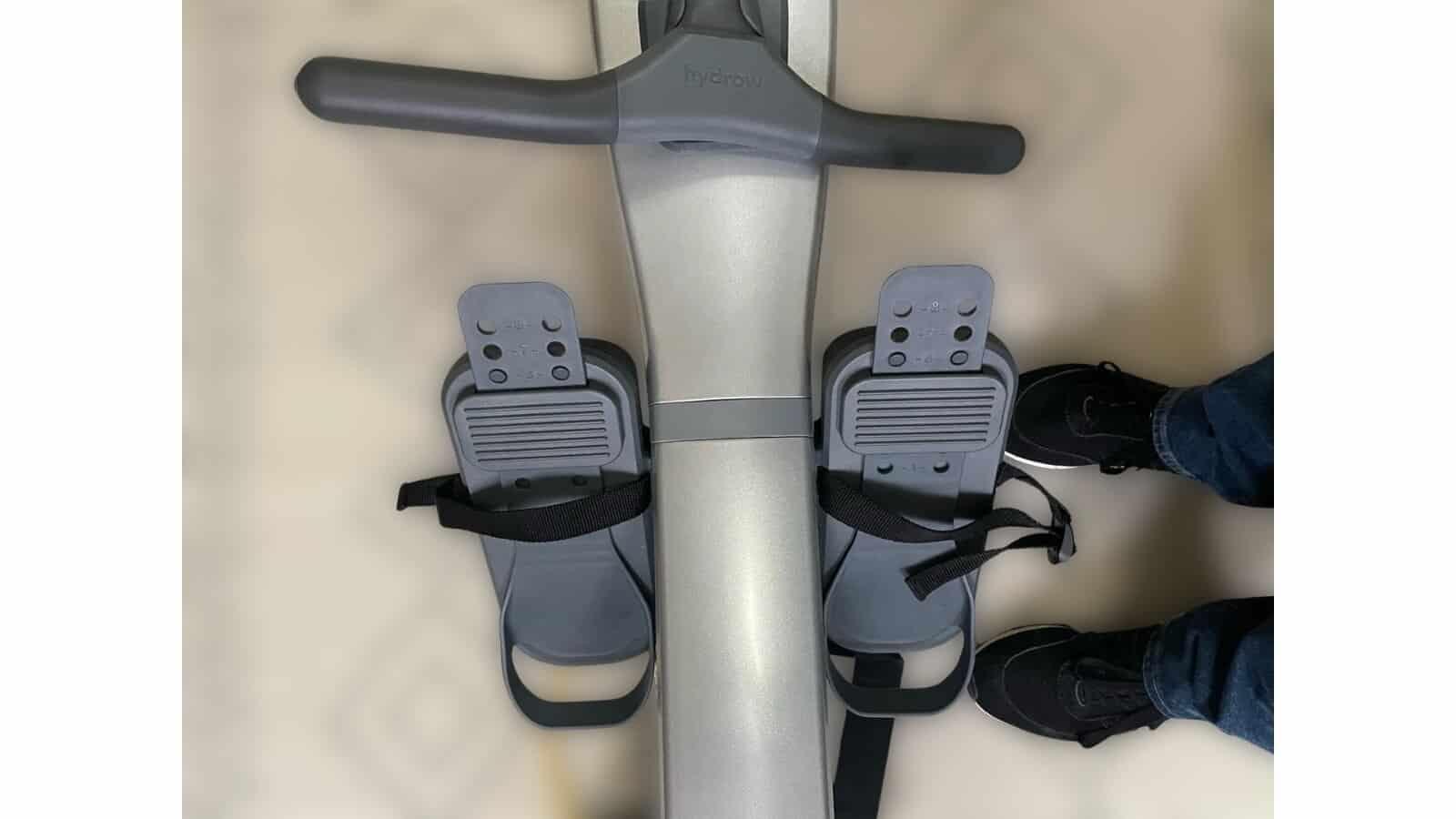
All three rowers deliver essentially the same rowing experience. The electromagnetic resistance is smooth and realistic across the board. The seat comfort is identical. The handle and foot cradles are the same.
The Arc’s HydroMetrics provides additional performance insights, but it doesn’t change how the rower feels during your workout. If you care deeply about data and technique optimization, it’s valuable. If you just want a great workout, you won’t miss it.
Content Access
Every model gets access to the same content library with the $44/month membership. Live classes, on-demand rows, outdoor sessions, off-rower workouts. It’s all identical regardless of which rower you choose.
The difference is in how you experience that content. The Arc’s larger screen and advanced rotation make off-rower workouts more enjoyable. The Origin’s 22-inch rotating screen is a good middle ground. The Wave’s fixed 16-inch screen is fine for rowing but limiting for everything else.
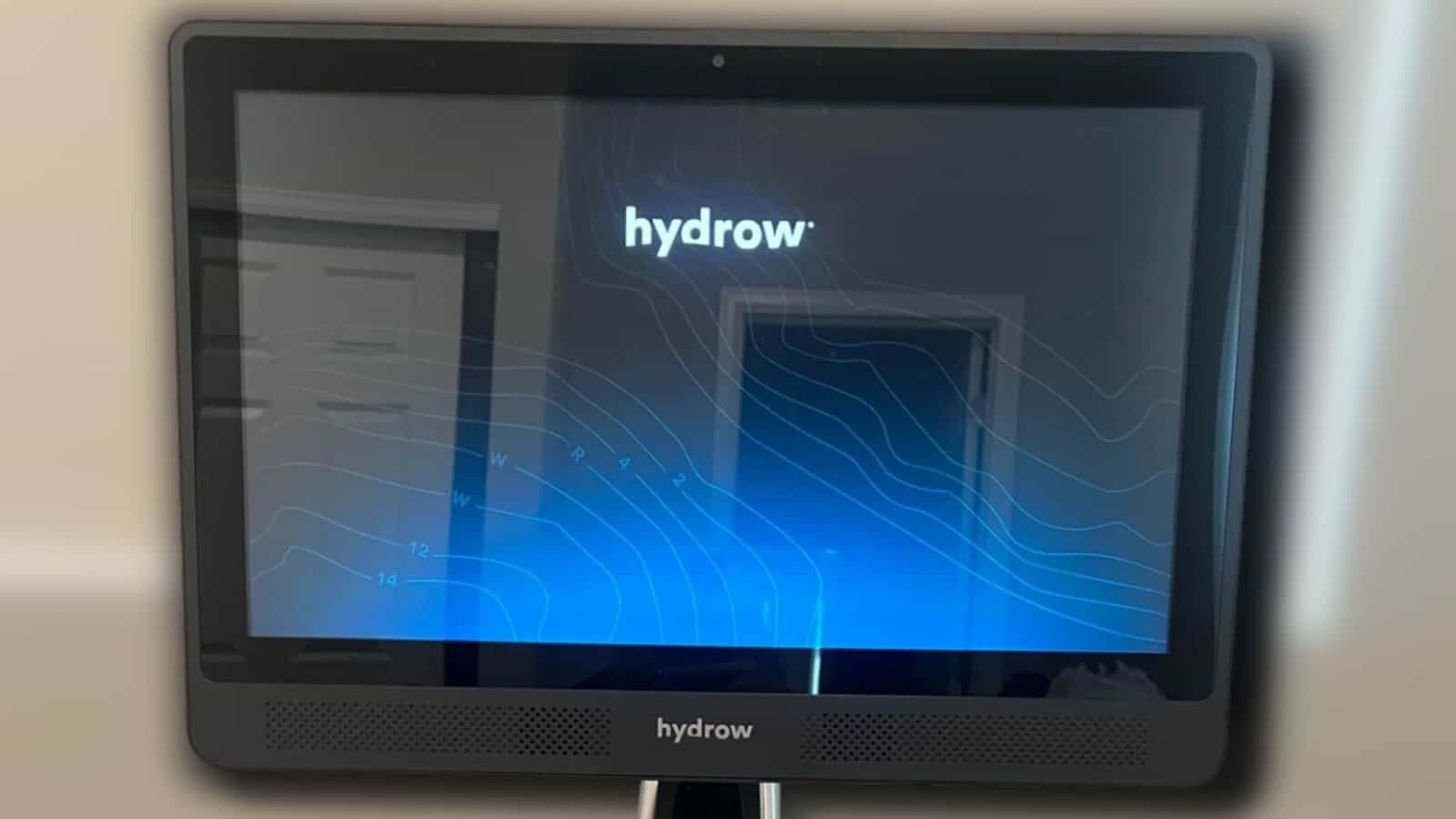
Space Considerations
If space is tight, the Wave is the obvious choice. It’s 6 inches shorter in length, 6 inches narrower, and 5 inches lower than the other models. More importantly, it’s 40+ pounds lighter, making it much easier to move and store.
The Arc and Origin require nearly identical space. Unless you specifically want HydroMetrics or prefer the slightly larger screen on the Arc, there’s no practical difference between them in terms of footprint.
Value Proposition
The Wave offers the best value. You’re getting 90% of the Hydrow experience for significantly less money. The compromises (smaller screen, no rotation, plastic frame) are minor compared to the savings.
The Origin is a solid middle option, but it’s hard to justify the extra $700+ over the Wave unless you’re certain you’ll use a lot of off-rower content.
The Arc is for enthusiasts. If you’re serious about rowing, love data, and want the most premium experience Hydrow offers, the HydroMetrics system and 24-inch screen are worth the investment. For everyone else, it’s probably overkill.
The Reality of Using Hydrow
After months of rowing on these machines, a few things have become clear about the day-to-day experience.
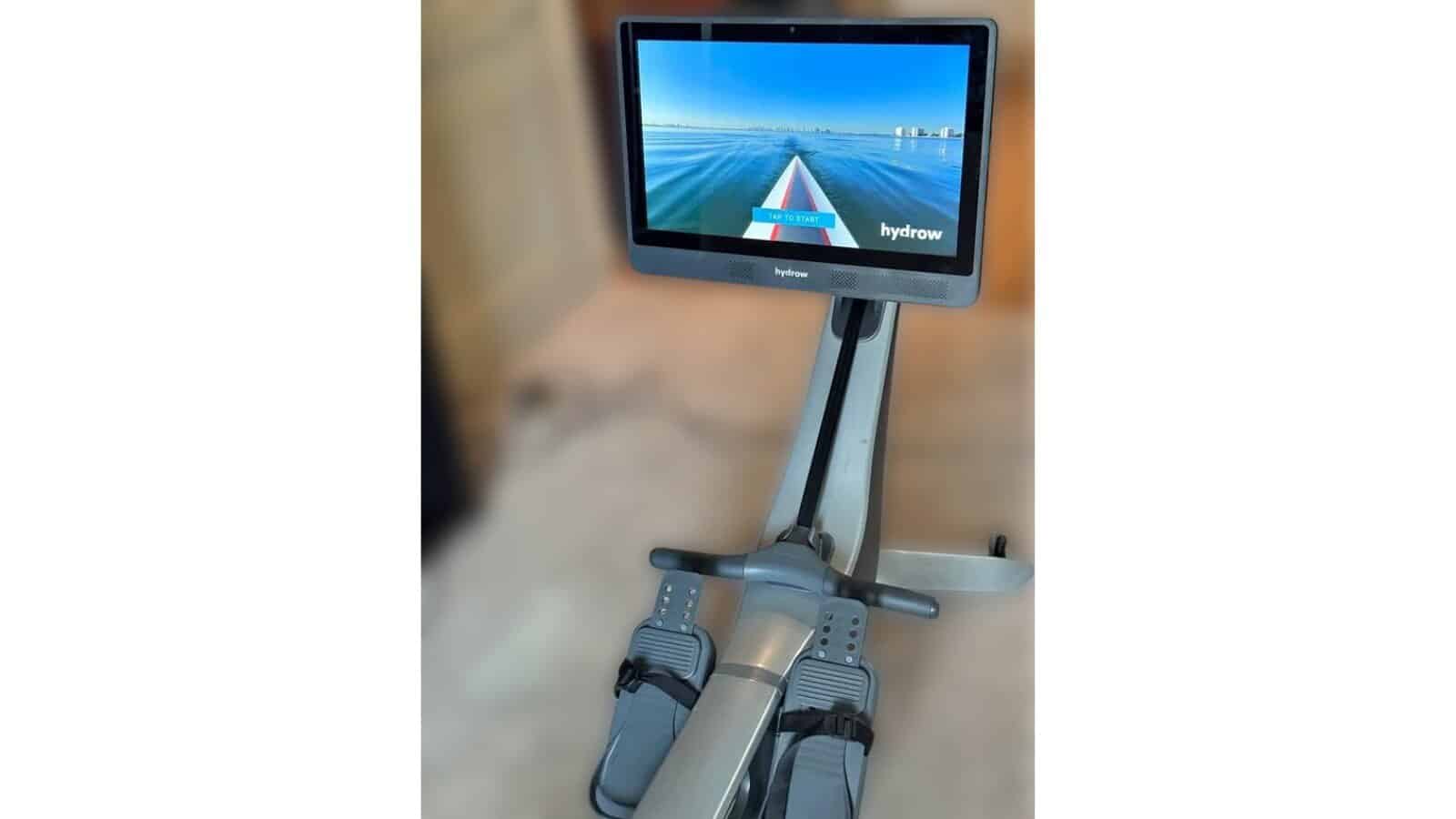
The Membership Is Non-Negotiable
I mentioned this earlier, but it bears repeating…these rowers are borderline useless without the membership.
The “Just Row” mode is bare-bones. You can’t save workouts, you can’t track progress over time, and you can’t connect to services like Strava. You’re essentially paying premium prices for a fancy resistance mechanism and a screen that displays basic stats.
Hydrow is upfront about this. Their position is that if you don’t want to pay for the membership, buy a Concept2. And they’re right. Without the content and community features, there’s no reason to choose Hydrow over a simpler, cheaper alternative.
The $44/month cost adds up to $528 per year. Over the typical 5-7 year lifespan of a rowing machine, you’re looking at $2,640 to $3,696 in membership fees on top of the hardware cost. This is a significant long-term investment.
That said, if you were paying for a gym membership, $44/month is competitive. And unlike a gym, this covers your entire household with unlimited user profiles. You can also purchase various accessories.
The Content Is Legitimately Good
I’ve tested smart rowers from Aviron (gaming-focused), Ergatta (minimalist with basic games), and now Hydrow. Hydrow’s content is in a different league.
The outdoor rowing sessions are genuinely immersive. The instructors are engaging without being annoying. The camera work is high-quality. The variety is impressive. I’ve rowed through locations I’ll probably never visit in real life, and it makes the workout fly by.
The structured programs (like “Learn to Row,” “Fitness Builder,” and various endurance challenges) provide direction if you don’t want to just pick random workouts. This is especially valuable for beginners who need guidance on building a consistent routine.
One feature I particularly appreciate: you can adjust the audio mix during a workout to hear only the music or only the instructor. If I’m doing a recovery row and just want to zone out to music while watching the scenery, I can mute the instructor entirely. Small detail, but it matters.
Form Matters More Than You Think
Rowing looks simple. Pull a handle, slide back, repeat.
In reality, proper rowing form is technical, and bad form can lead to lower back pain or other injuries.
Hydrow addresses this with “Learn to Row” videos and technique-focused classes. The Arc’s HydroMetrics takes it further by analyzing your stroke and identifying specific areas for improvement.
The platform also offers one-on-one coaching sessions via Zoom where an actual Hydrow coach will watch you row and provide personalized feedback. I haven’t used this feature personally, but the team member who did found it helpful for fixing a subtle catch timing issue that was causing discomfort.
If you’re new to rowing, don’t skip the technique content. Fifteen minutes learning proper form will save you from weeks of frustration and potential injury.
The Social Features Work
The leaderboard, challenges, and badges are more motivating than I expected. I’m competitive by nature, so seeing my ranking during a live class pushes me to maintain output even when I’m tired.
The mobile app includes a social feed where you can see summaries of workouts completed by people you follow. It’s not as robust as Peloton’s social features, but it’s enough to create a sense of community.
Hydrow also runs charity challenges where your meters contribute to a collective goal that benefits a specific organization. Nice touch that adds purpose beyond personal fitness.
Practical Considerations
A few things to keep in mind that don’t fit neatly into other sections:
Wi-Fi connectivity is crucial. The rower requires a stable internet connection to stream content. If your router is far from where you’re placing the rower, you might experience buffering or lag. Hydrow recommends using an Ethernet connection for the most reliable experience.
Clean the rower after every use. Sweat and moisture can damage the rails and other components over time. A quick wipe-down takes 30 seconds and extends the life of the machine.
Wear proper footwear. Your heels will naturally lift during the rowing stroke (that’s normal and expected). But you need shoes with a secure heel so they don’t slip out of the foot cradles. Rowing barefoot or in socks isn’t ideal.
Consider a mat. Placing a mat under the rower protects your flooring and makes cleanup easier. It also reduces the already minimal noise even further.
Warranty and Customer Support
Hydrow’s warranty varies by model but follows a similar structure:
Arc and Origin:
- Structural frame: 5 years
- Components, electronics, screens, and labor: 12 months
Wave:
- Structural frame: 5 years
- Components, electronics, screens, and labor: 12 months
These warranties are shorter than some competitors. Concept2, for example, offers a 5-year frame warranty and 2-year parts warranty. That said, I’ve owned other Hydrow models for multiple years without any issues, so the durability seems solid despite the limited warranty period.
Hydrow offers a 30-day return window, which is generous. If you’re not satisfied, they’ll arrange pickup and handle return shipping for free. The only exception is white glove delivery service (if you paid extra for that, it’s not refundable).
Shipping is typically $150 for all models, though Hydrow frequently runs promotions with free shipping. The Wave ships via UPS in a standard box, while the Arc and Origin arrive on freight pallets.
Delivery was fast in my experience. The Wave arrived within 5 days of ordering. The Origin took about a week. White glove delivery is available for an additional fee (the delivery team will bring the rower inside, set it up, and take all packaging with them).
Which Hydrow Should You Buy?
After testing all three models extensively, here’s my honest recommendation for different types of buyers:
Buy the Wave if:
- You have limited space or need a rower that’s easy to move and store
- You’re primarily interested in rowing (not off-rower workouts)
- You want the best value and don’t care about having the largest screen
- You live in an apartment and need something that ships via standard delivery
- You’re new to rowing and want to test the waters without a massive investment
The Wave is the smart choice for most people. You’re getting the core Hydrow experience at a significantly lower price.
Buy the Origin if:
- You want a larger screen than the Wave but don’t need the advanced metrics of the Arc
- You plan to use a lot of the off-rower content (yoga, strength training, etc.) and want a screen that rotates
- You prefer the aesthetic and feel of a metal frame over polymer
- You can find it on sale for close to the Wave’s price (which sometimes happens)
Honestly, the Origin is the hardest to recommend. It sits in an awkward middle ground. Unless you find a great sale, you’re better off either saving money with the Wave or going all-in on the Arc.
Buy the Arc if:
- You’re serious about rowing and want detailed performance analytics
- You’re willing to pay premium for the best possible experience
- You love data and want AI-powered insights to improve your technique
- You plan to use the rower for both rowing and extensive off-rower workouts
- You want the largest screen and most advanced features Hydrow offers
The Arc is for enthusiasts. If you’re reading this review and thinking “I’m not sure if I need HydroMetrics,” you probably don’t. But if you immediately recognized the value of form analysis and performance tracking, the Arc is worth the investment.
Hydrow vs the Competition
You’re probably cross-shopping, so how does Hydrow compare to other popular rowing machines?
The Concept2 is the industry standard. Durable, reliable, and used in gyms worldwide. It’s an air rower, so it’s louder than any Hydrow model. It has no screen, no content, and no guided workouts. But it’s also $900-1000 with no monthly subscription required.
If you’re a serious rower who just wants a reliable machine to track splits and don’t care about entertainment or coaching, get the Concept2. If you want an engaging experience with immersive content, get a Hydrow.
Ergatta is a water rower with a screen that focuses on game-based workouts. It’s beautiful, quiet, and the games are fun for some people. But the content library is much smaller than Hydrow’s, and in my testing, the games got repetitive fairly quickly.
Hydrow’s outdoor rowing content is far more engaging and varied than Ergatta’s gaming approach.
Peloton competes directly with Hydrow in the premium smart rower category. Both have strong content ecosystems and engaged communities. Hydrow’s on-water outdoor rowing sets it apart. Peloton leans into its studio class format (which works well for their bikes and treadmills), but if you’re drawn to the immersive outdoor experience, Hydrow wins that specific battle.
Aviron takes the gaming approach to an extreme, with Netflix integration and various game modes. It’s fun, but if you’re looking for serious rowing training, Hydrow’s coaching-focused content is superior.
Final Verdict
Hydrow has created the most immersive indoor rowing experience available. The outdoor content is genuinely special, the resistance system is smooth and realistic, and the hardware quality across all three models is excellent.
But these aren’t casual purchases. Between the upfront hardware cost and the mandatory monthly subscription, you’re making a significant financial commitment. Over five years, even the budget-friendly Wave will cost you around $4,000 all-in.
Is it worth it? If you genuinely enjoy rowing (or if you’re willing to learn and commit to it), yes. The engagement factor is high enough that you’ll actually use it, which is more than you can say for most home fitness equipment.
My personal favorite is the Wave. It delivers everything that makes Hydrow special at a price point that’s much easier to justify. Unless you specifically need the larger rotating screen or the HydroMetrics features, I’d save the money and put it toward your membership fees.
If I were buying today, I’d get the Wave, commit to the membership for a year, and see how it goes. If after a year I’m still rowing regularly and wanting more from the off-rower content, I’d consider upgrading to the Arc. But I suspect most people would be perfectly happy with the Wave indefinitely.
These are excellent rowing machines backed by the best content platform in the industry. Just make sure you’re ready to commit to the membership, because without it, you’re better off with a simpler, cheaper alternative.
FAQ
Do I really need the Hydrow membership?
Technically no, but practically yes. Without the $44/month membership, you can use “Just Row” mode to see basic metrics, but you can’t save workouts, track progress over time, access any content, join challenges, or connect to services like Strava. You’re essentially paying premium prices for a resistance mechanism. Hydrow is honest about this (if you don’t want the membership, they recommend buying a different rower).
Can multiple people use one Hydrow membership?
Yes. The membership includes unlimited user profiles for your entire household. Each person gets their own account with individual metrics, progress tracking, and workout history. This makes the $44/month cost more reasonable if multiple people are using the rower.
How much space do I need for a Hydrow?
The Arc and Origin require about 86 inches of length and 25 inches of width, plus you’ll want a few extra feet of clearance around the machine. The Wave is more compact at 80 inches long and 19 inches wide. All models can be stored vertically to reduce footprint when not in use (the Wave has this built-in, while the Arc and Origin require an $80 storage kit).
How tall do I need to be to use Hydrow?
All three models accommodate users up to a 36-inch inseam, which typically corresponds to heights between 6’4″ and 6’8″. The rail length is the same across all models at 47 inches of travel, so you won’t feel cramped regardless of which Hydrow you choose.
Is Hydrow loud?
It depends on what you’re comparing it to. All three Hydrow models are significantly quieter than air rowers like the Concept2. However, they’re not completely silent. I noticed audible noise with each pull stroke, particularly on the Arc. The sound level is comparable to a water rower. It’s quiet enough for apartment use in most cases, but not whisper-quiet.
What’s the difference between the Arc, Origin, and Wave?
The Arc ($2,295) has the largest screen (24″), HydroMetrics AI performance tracking, and rotating/tilting screen. The Origin (~$2,200) has a 22″ rotating screen but no HydroMetrics. The Wave (under $1,500) has a smaller 16″ fixed screen, lighter polymer frame, and ships via UPS. All three have identical resistance systems and access to the same content library with a membership.
Is HydroMetrics worth the extra cost?
Only if you’re serious about technique optimization and love detailed performance data. HydroMetrics analyzes your rowing form and provides AI-powered insights on precision, power, and endurance after every session. It’s genuinely useful for improving technique, but most casual users won’t miss it. If you’re asking whether you need it, you probably don’t.
Can I watch Netflix on Hydrow?
No. Unlike some other smart fitness equipment, Hydrow doesn’t offer Netflix or other third-party streaming apps. The screen is dedicated to Hydrow’s content library and workout interface. You’re locked into the Hydrow ecosystem, which is intentional (they want you engaging with their training content).
What kind of maintenance does Hydrow require?
Minimal. You should wipe down the rower after each use to remove sweat and moisture, which can damage components over time. Periodically check that all bolts are tight and the seat rolls smoothly. The electromagnetic resistance system is sealed and maintenance-free. There’s no water to change or air intake to clean like with other rower types.
Does Hydrow work with Apple Watch or other fitness trackers?
Yes. Hydrow supports Bluetooth heart rate monitors, including Apple Watch (through the Hydrow mobile app), Garmin, Polar, Wahoo, and Whoop devices. Your heart rate will display on screen during workouts. Hydrow also integrates with Strava to automatically post workout summaries and stats if you want to track training across platforms.
Can I use Hydrow without Wi-Fi?
Sort of, but not really. You can use “Just Row” mode offline to see basic metrics, but you can’t access any content, save workouts, or use most features without an internet connection. Hydrow requires Wi-Fi (or Ethernet for more stability) to stream classes and sync data. If your router is far from the rower’s location, you might experience buffering issues.
What’s the return policy?
Hydrow offers a 30-day return window from delivery. If you’re not satisfied, they’ll arrange pickup and handle return shipping for free. The only cost not covered is white glove delivery service if you paid extra for that. This is a generous policy that reduces risk if you’re unsure whether rowing is right for you.
How long does Hydrow take to deliver?
In my experience, the Wave arrived within 5 days, while the Origin took about a week. The Arc took slightly longer. Delivery times may vary based on your location and current demand. The Wave ships via standard UPS in a box, while the Arc and Origin ship on freight pallets, which can affect delivery scheduling.
Is Hydrow good for beginners?
Yes. The platform includes “Learn to Row” content specifically designed for beginners, teaching proper form and technique. You can filter workouts by skill level, so you’re not thrown into advanced classes before you’re ready. The structured programs help you build a consistent routine. The biggest challenge for beginners is justifying the cost before knowing if you’ll stick with rowing long-term.
How does Hydrow compare to gym rowing machines?
Most gym rowing machines are either Concept2 RowErgs (air resistance, no screen) or cheaper water/magnetic rowers with minimal features. Hydrow offers a much more engaging experience with guided coaching, immersive outdoor content, and smooth electromagnetic resistance. The hardware quality is also higher than typical gym equipment. If you have access to a gym with nice rowing machines, you’ll need to decide if the home convenience and content library justify the investment.
Can I get coaching or form feedback?
Yes. Beyond the technique-focused classes, Hydrow offers one-on-one coaching sessions via Zoom where an actual coach will watch you row and provide personalized feedback. This is included with your membership. The Arc’s HydroMetrics also provides automated form analysis after each session, identifying areas for improvement in your stroke mechanics.
Final Thought: Hydrow has genuinely revolutionized indoor rowing. The experience is engaging enough that you’ll actually use it, which is ultimately what matters most with any fitness equipment. Just make sure you’re ready for the long-term financial commitment before you buy.

